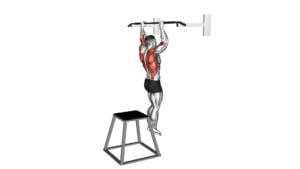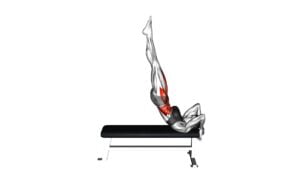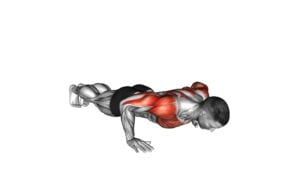Pull-up (negative) (female) – Video Exercise Guide & Tips

Looking to strengthen your upper body and build more muscle? In this video exercise guide, we'll show you how negative pull-ups can benefit females like you.
Watch This Exercise Video
Learn the proper form and technique to maximize your results, and discover common mistakes to avoid. We'll also provide modifications and progressions to suit your fitness level.
Increase your strength and endurance with our expert tips, and get ready to conquer your pull-up goals.
Let's get started!
Key Takeaways
- Negative pull-ups for females target the back, shoulders, and arms while building upper body strength.
- Engaging the core muscles is crucial for stability and effective performance during negative pull-ups.
- Proper form and technique, including maintaining straight body position and aligning elbows with wrists and shoulders, are essential for avoiding strain on joints.
- Modifications and progressions, such as assisted negative pull-ups and eccentric pull-ups, can be used to tailor the exercise to different fitness levels.
Benefits of Negative Pull-Ups for Females
To maximize your strength gains, incorporate negative pull-ups into your training routine as a female. Negative pull-ups are an effective exercise that targets your back, shoulders, and arms, helping you build upper body strength. However, it's crucial to warm up properly before attempting negative pull-ups to prevent injuries and ensure optimal performance.
Warming up before any exercise is essential to prepare your muscles and joints for the activity. Prior to negative pull-ups, it's recommended to perform dynamic stretches and movements that target the muscles involved in the exercise. This will increase blood flow, improve flexibility, and reduce the risk of strains or sprains.
Despite taking precautions, injuries can still occur during negative pull-ups. The most common injuries associated with this exercise are shoulder strains and elbow tendonitis. To prevent these injuries, it's important to maintain proper form throughout the exercise, engage your core for stability, and avoid swinging or jerking movements. Additionally, gradually increasing the intensity and volume of your negative pull-ups over time will allow your muscles and connective tissues to adapt and become stronger.
If you do experience any injuries, it's crucial to treat them promptly. Resting, applying ice, and using anti-inflammatory medications can help reduce pain and inflammation. However, if the pain persists or worsens, it's advisable to seek medical attention to prevent further damage.
Proper Form and Technique for Negative Pull-Ups
To perform negative pull-ups with proper form and technique, it's crucial to pay attention to the position of your elbows. Keep your elbows slightly tucked in towards your body throughout the movement to effectively target the muscles in your back and arms.
Additionally, engage your core muscles by maintaining a straight and stable body position from head to toe, avoiding any swinging or arching of the back.
Elbows Position During Negatives
Maintain proper elbow position for optimal form and technique during negative pull-ups. Elbow alignment is crucial to ensure effective engagement of the muscles involved and to prevent injuries. Keep your elbows in line with your wrists and shoulders throughout the exercise.
This alignment helps to maintain proper shoulder stability and prevents unnecessary strain on the joints. When performing negative pull-ups, focus on lowering yourself down slowly and controlled, while maintaining this elbow position. Avoid letting your elbows flare out to the sides or collapse inward.
Engaging the Core Muscles
Engage your core muscles to maintain proper form and technique during negative pull-ups. Your core stability and abdominal strength play a crucial role in performing this exercise effectively. Here's what you need to know:
- Maintain a strong and stable core: By contracting your abdominal muscles, you create a solid foundation for your upper body to perform the movement.
- Avoid excessive arching or rounding of the back: Keep your spine neutral throughout the exercise to prevent strain on your lower back.
- Tuck your pelvis slightly: This helps to engage your lower abdominal muscles and maintain proper alignment.
- Squeeze your glutes: Activating your glute muscles helps to stabilize your pelvis and maintain a strong core.
Common Mistakes to Avoid During Negative Pull-Ups
When performing negative pull-ups, it's important to avoid common mistakes that can hinder your progress.
One common mistake to avoid is incorrect grip positioning, as this can put unnecessary strain on your wrists and forearms.
Additionally, make sure to engage your core throughout the exercise to maintain stability and prevent excessive swinging.
Incorrect Grip Positioning
To avoid incorrect grip positioning during negative pull-ups, start by ensuring that you place your hands shoulder-width apart on the bar. This will help you maintain a proper grip and avoid any unnecessary strain on your wrists. When gripping the bar, it's important to avoid applying too much pressure with your fingers, as this can lead to discomfort and potentially even injuries. Instead, focus on evenly distributing the pressure across your entire hand, using a firm but not overly tight grip.
Additionally, pay attention to your wrist alignment during negative pull-ups. Keep your wrists straight and avoid any excessive bending or hyperextension, as this can put unnecessary stress on your joints.
By maintaining proper grip positioning and wrist alignment, you can perform negative pull-ups more effectively and reduce the risk of injury.
Now, let's move on to the next common mistake: lack of core engagement.
Lack of Core Engagement
To maintain proper form and maximize the effectiveness of your negative pull-ups, it's crucial to actively engage your core throughout the exercise.
Core stability plays a significant role in maintaining control and balance during the movement. When you lack core engagement, your body becomes unstable, compromising your ability to perform the exercise correctly.
Your core muscles, including the transverse abdominis, obliques, and lower back muscles, need to be activated to provide a stable base for your upper body. By engaging your core, you create a solid foundation that allows for optimal muscle activation in your upper body, particularly in the back and arms.
This not only helps you perform the negative pull-up with better control but also ensures that you're targeting the intended muscles effectively.
Modifications and Progressions for Female Negative Pull-Ups
To modify and progress your female negative pull-ups, you can incorporate various techniques and exercises. Here are some modifications and progressions you can try:
- Assisted Negative Pull-Ups: Use a resistance band or an assisted pull-up machine to help support your body weight as you perform the negative portion of the pull-up. This can help build strength and improve your form before attempting full pull-ups.
- Eccentric Pull-Ups: Instead of starting from a dead hang position, begin with your chin above the bar and slowly lower yourself down in a controlled manner. Focus on engaging your back muscles throughout the movement.
- Isometric Holds: At the top of the pull-up, hold the position for a few seconds before lowering yourself down. This will help develop strength and stability in the upper body.
- Band-Assisted Pull-Ups: Attach a resistance band to the pull-up bar and loop it around your feet or knees. The band will provide assistance as you pull yourself up, making the exercise more manageable.
- Wide Grip Pull-Ups: By widening your grip on the bar, you engage different muscles in the back and arms, making the exercise more challenging.
- Weighted Pull-Ups: Once you have mastered the bodyweight negative pull-ups, you can add extra resistance by wearing a weighted vest or holding a dumbbell between your feet.
Tips for Increasing Strength and Endurance in Negative Pull-Ups
Follow these three tips to increase your strength and endurance in negative pull-ups.
- Gradually increase difficulty: To build strength and endurance in negative pull-ups, it's important to gradually increase the difficulty of the exercise. Start by using a resistance band to assist you in the movement, and as you become more comfortable and stronger, gradually decrease the assistance provided by the band. Eventually, you can progress to performing negative pull-ups without any assistance.
- Focus on proper form and technique: To maximize the benefits of negative pull-ups, it's crucial to maintain proper form and technique throughout the exercise. Engage your core, keep your shoulders down and back, and pull yourself up with control as you slowly lower yourself back down. Avoid using momentum or swinging, as this can decrease the effectiveness of the exercise and increase the risk of injury.
- Incorporate progression techniques: To continue challenging your muscles and making progress, incorporate different progression techniques into your negative pull-up routine. This can include adding weight using a weight belt or holding a dumbbell between your feet, performing slow eccentric reps, or even adding pauses at different points in the movement. These techniques will help to further increase the difficulty and stimulate muscle growth.
Sample Workout Routine Incorporating Female Negative Pull-Ups
To incorporate female negative pull-ups into your workout routine, consider the following sample exercises and repetitions:
- Warm-up: Start with a 5-minute cardio activity such as jogging or jumping jacks to get your blood flowing and muscles warmed up.
- Assisted Pull-Ups: Begin with assisted pull-ups using a resistance band or pull-up machine. Aim for 3 sets of 8-10 repetitions, gradually increasing the resistance as you get stronger.
- Workout Variation 1: Use a wide grip for a greater emphasis on your back muscles.
- Workout Variation 2: Try a close grip to target your biceps and upper back more intensely.
- Negative Pull-Ups: Once you feel comfortable with assisted pull-ups, move on to negative pull-ups. Begin at the top of the pull-up position and slowly lower yourself down to a 90-degree elbow bend. Aim for 3 sets of 5-8 repetitions.
- Workout Variation 1: Use a slower tempo during the eccentric phase to increase muscle tension and build strength.
- Workout Variation 2: Add a pause at the bottom of the movement to challenge your muscles even more.
- Cool-down: Finish your workout with a 5-minute stretching routine to promote muscle recovery and reduce soreness.
Remember to listen to your body and adjust the exercises and repetitions based on your fitness level. With consistency and proper form, you'll be on your way to mastering negative pull-ups and improving your upper body strength.
Frequently Asked Questions
Can Negative Pull-Ups Help Me Lose Weight?
Yes, negative pull-ups can help you lose weight.
By incorporating negative pull-ups into your workout routine, you engage multiple muscle groups, which increases your overall calorie burn.
Additionally, negative pull-ups improve muscle definition, helping you achieve a leaner physique.
Moreover, they contribute to increasing your overall fitness levels by building strength in your upper body and core.
Incorporating negative pull-ups into your fitness routine can be a beneficial addition to your weight loss journey.
How Often Should I Do Negative Pull-Ups to See Results?
To see results from negative pull-ups, it's important to find the optimal rest time between sessions. This will vary depending on your fitness level, but generally, allowing 48 to 72 hours of rest between workouts is recommended.
To maximize results, consider combining negative pull-ups with other upper body exercises, such as push-ups and rows. This will help to strengthen and tone your entire upper body.
Remember to consult with a fitness professional for personalized advice.
Can Negative Pull-Ups Help Improve My Posture?
Negative pull-ups can definitely help improve your posture. By focusing on the eccentric portion of the exercise, you engage the muscles responsible for shoulder stability. This can lead to improved alignment and reduced rounding of the shoulders, which is often associated with poor posture.
Additionally, negative pull-ups can also help with back pain relief. As you lower yourself down, you activate the muscles in your back, promoting strength and stability, which can alleviate discomfort.
Are Negative Pull-Ups Suitable for Beginners?
Negative pull-ups can be a great addition to your workout routine, especially for beginners. They help you build the necessary strength and technique to eventually perform full pull-ups.
To ensure proper form, start by standing on a box or step to lift yourself up to the top position of the pull-up. Slowly lower yourself down, focusing on engaging your back and core muscles.
The benefits of incorporating negative pull-ups include improved upper body strength, increased muscle definition, and enhanced posture.
Can Negative Pull-Ups Help With Upper Body Strength for Other Exercises Like Push-Ups or Bench Presses?
Negative pull-ups can be a great addition to your upper body strength training routine. They're especially effective for building strength in your back, shoulders, and arms, which can benefit other exercises like push-ups and bench presses.
Compared to assisted pull-ups, negative pull-ups require more control and engage your muscles differently. By incorporating negative pull-ups into your full body workout routine, you can enhance overall muscle development and improve your strength in various exercises.
Conclusion
Incorporating negative pull-ups into your workout routine can offer numerous benefits for females. By focusing on the eccentric phase of the exercise, negative pull-ups help build strength in the upper body, particularly the back and arms.
Proper form and technique are crucial to maximize the effectiveness of this exercise. Avoid common mistakes such as swinging or using momentum.
Modifications and progressions can be made to cater to individual fitness levels. By following these tips and consistently working on negative pull-ups, you can increase your strength and endurance over time.

Author
Years ago, the spark of my life’s passion ignited in my mind the moment I stepped into the local gym for the first time. The inaugural bead of perspiration, the initial endeavor, the very first surge of endorphins, and a sense of pride that washed over me post-workout marked the beginning of my deep-seated interest in strength sports, fitness, and sports nutrition. This very curiosity blossomed rapidly into a profound fascination, propelling me to earn a Master’s degree in Physical Education from the Academy of Physical Education in Krakow, followed by a Sports Manager diploma from the Jagiellonian University. My journey of growth led me to gain more specialized qualifications, such as being a certified personal trainer with a focus on sports dietetics, a lifeguard, and an instructor for wellness and corrective gymnastics. Theoretical knowledge paired seamlessly with practical experience, reinforcing my belief that the transformation of individuals under my guidance was also a reflection of my personal growth. This belief holds true even today. Each day, I strive to push the boundaries and explore new realms. These realms gently elevate me to greater heights. The unique combination of passion for my field and the continuous quest for growth fuels my drive to break new ground.







